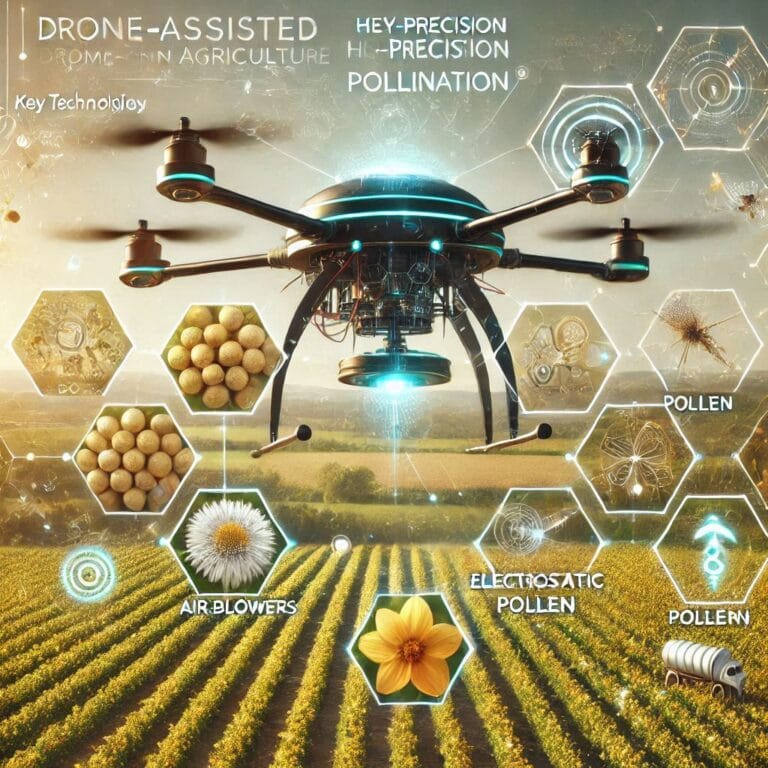Introduction: A New Era of Intelligence from Above
Imagine drones and satellites not just capturing data, but processing it in real-time from the skies. Instead of waiting for data to be transmitted back to Earth for analysis, insights are generated instantly—right where the data originates. This isn’t science fiction—it’s the emerging reality of aerial computing.
At its essence, drone-edge networks blends edge processing with airborne systems such as drones and satellites, bringing real-time intelligence to the skies. By embedding processing power directly into these aerial devices, data can be analyzed on-the-fly, enabling faster decision-making and reducing reliance on centralized data centers.

This technological paradigm shift is particularly transformative in sectors that demand real-time intelligence in remote or rapidly changing environments. In disaster management, for instance, drones equipped with aerial computing capabilities can assess damage and identify survivors in real time. In agriculture, edge computing on satellites can optimize crop monitoring and irrigation decisions without delay. For urban planning, this means more responsive infrastructure management based on live aerial insights.
As the demand for low-latency, high-efficiency data processing grows, it stands at the forefront of technological evolution—offering a scalable, mobile, and intelligent layer above the Earth that reshapes how we collect and act on information.
Understanding Aerial Computing: A Sky-Borne Paradigm Shift
At its essence, it is a forward-thinking computing paradigm that merges aerial radio access networks with edge computing to deliver decentralized, low-latency processing capabilities via airborne platforms. These platforms include unmanned aerial vehicles (UAVs), high-altitude platforms (HAPs), and satellites, forming a versatile and dynamic infrastructure capable of serving regions with little to no ground-based connectivity.
Unlike traditional cloud or edge networks that rely heavily on terrestrial infrastructure, drone-edge networks leverages the mobility and flexibility of airborne systems. This allows data to be processed closer to its source—even in hard-to-reach or rapidly changing environments—enabling real-time insights and minimizing the latency associated with sending data back to centralized servers.
How Aerial Computing Differs from Traditional Models
Conventional computing infrastructures are geographically fixed, often limited by the availability of physical data centers or network towers. In contrast, drone-edge networks platforms like UAVs and HAPs can be dynamically deployed and repositioned in response to emerging needs, such as a natural disaster or an agricultural pest outbreak. These flying data centers bring computational intelligence to the skies, bypassing the constraints of ground-based systems.
Core Components of the Aerial Computing Ecosystem
- Unmanned Aerial Vehicles (UAVs): Also known as drones, UAVs are agile, low-altitude aerial systems that can carry edge computing units for tasks like environmental monitoring, infrastructure inspection, and surveillance.
- High-Altitude Platforms (HAPs): Operating in the stratosphere, HAPs are long-endurance aerial systems—such as balloons, airships, or solar-powered aircraft—that can serve as semi-permanent data relays and processing hubs above the clouds.
- Satellites: These are the highest-level airborne assets in the aerial computing stack, offering wide-area coverage and connectivity for regions with little terrestrial infrastructure.

As a transformative computing paradigm, aerial computing is not just about placing processors in the sky—it’s about rethinking how we deploy, scale, and deliver computational resources on a global scale. This paradigm has the potential to bridge the digital divide, enable smarter global logistics, and power real-time analytics from places where no cable has ever reached.
The Evolution from Cloud to Sky Computing
To understand the future of aerial computing, it’s crucial to first trace the broader journey of computational paradigms—from centralized clouds to decentralized skies.
Cloud Computing: A Foundational Shift
Cloud computing revolutionized how data and applications are stored, accessed, and managed. It enabled scalability, flexibility, and cost-efficiency by allowing users to leverage remote servers hosted on the internet. However, this model comes with critical limitations, particularly for latency-sensitive applications such as autonomous vehicles, remote surgeries, or real-time surveillance. The physical distance between the data source and the cloud data center introduces latency, bandwidth constraints, and reduced responsiveness.
Edge Computing: Bridging the Gap
To overcome these challenges, edge computing emerged as a powerful intermediary step. By pushing computation closer to the data source—on local servers, gateways, or even user devices—this significantly reduces latency, enhances data privacy, and supports real-time processing. This shift is especially critical in applications requiring instant decision-making, such as industrial automation, smart cities, and augmented reality.
Sky Computing: A New Layer of Abstraction
Building on these foundations, it has emerged as the next evolutionary stage. Defined as a computing paradigm that abstracts and integrates multiple cloud services into a single, interoperable platform, sky computing allows organizations to seamlessly utilize resources across AWS, Google Cloud, Azure, and private clouds. This unified framework enhances scalability, fault tolerance, and global accessibility.
In the context of aerial computing, sky computing can serve as the backbone for coordinating multiple edge and cloud layers, whether they are on UAVs, high-altitude platforms, or satellites.
By combining the low-latency benefits of edge computing with the cross-cloud flexibility of sky computing, modern systems are becoming increasingly distributed, intelligent, and adaptive—paving the way for powerful applications from the ground to the stratosphere.
Aerial Computing vs. Sky Computing: Decoding the Differences
As next-gen computing paradigms continue to evolve, aerial computing and sky computing are often mentioned in tandem. While they share the sky as a common operational domain, their roles, architectures, and purposes are fundamentally distinct.
Aerial Computing: Processing at Altitude
It is a decentralized edge computing approach that utilizes airborne platforms—such as drones, high-altitude platforms (HAPs), and satellites—to perform real-time data processing and analytics. The primary goal is to minimize latency and enable intelligence in remote or mobile environments. For example, drone-edge networks can be used in disaster zones to process thermal imagery from UAVs for survivor detection or to analyze crop health in precision agriculture.
Sky Computing: A Unified Cloud Abstraction
In contrast, this is a cloud-first framework that unifies diverse cloud providers into one seamless, interoperable ecosystem. Instead of being tied to one cloud provider, users can access and combine services across different cloud ecosystems seamlessly. This abstraction enhances cloud computing by improving availability, scalability, and vendor neutrality.
Think of sky computing as a global orchestration layer, whereas it is a mobile, location-specific processing mechanism.
Where They Intersect
Interestingly, aerial computing can act as an edge extension of sky computing. For example:
- Data processed on aerial platforms can be seamlessly fed into sky computing systems for further analysis, storage, or distribution.
- A network of UAVs can leverage it to coordinate tasks across multiple cloud environments, using shared AI models or databases.
This convergence allows a truly global and adaptive computing architecture, where drone-edge networks enables real-time responsiveness at the edge, and sky computing ensures interoperability and coordination at scale.
Real-World Applications of Aerial Computing
As the capabilities of aerial computing evolve, they are already being applied in critical real-world scenarios across diverse sectors. By integrating UAVs with real-time data processing, aerial systems are revolutionizing the way we respond to emergencies, manage agriculture, and plan urban development.
Disaster Management: Real-Time Intelligence in Crisis Zones
In regions hit by disaster, rapid response and real-time situational insight are critical for effective relief efforts. UAVs equipped with edge processors can fly over affected regions and perform real-time data processing on high-resolution imagery to assess damage, identify survivors, and map out inaccessible zones. Unlike traditional drones that send data to a remote server for processing, aerial computing applications process data on-the-fly, reducing response time and enabling first responders to act decisively. Organizations like Cyient have pioneered such systems, using AI-powered UAVs to improve emergency coordination and relief delivery.
Agriculture: Smart Farming from the Skies
Modern agriculture is increasingly driven by data, and drone-edge networks plays a pivotal role in precision farming. UAVs can scan vast farmlands, analyzing crop health using multispectral and hyperspectral sensors. With embedded edge computing units, these drones deliver real-time data processing to detect issues like disease outbreaks, water stress, or nutrient deficiencies instantly. This enables farmers to take targeted action, optimizing the use of water, fertilizers, and pesticides—leading to healthier crops and sustainable practices.
Urban Planning: Data-Driven Cities
City planners are leveraging aerial computing applications to better understand and manage urban environments. UAVs can collect live traffic data, monitor construction projects, and assess infrastructure conditions. Through real-time data processing, aerial systems help visualize population density, road congestion, and urban heat islands. These insights are invaluable for developing smart cities with optimized traffic flow, improved public safety, and resilient infrastructure.
Technical Challenges and Considerations
Despite its transformative potential, drone-edge networks faces significant technical hurdles that must be addressed to enable widespread deployment and reliability.
UAV Energy Constraints: Limited Flight Time, Limited Computation
One of the primary UAV data infrastructure challenges is the limited energy supply of UAVs. Drones typically have a flight time ranging from 20 to 60 minutes, which restricts how long they can conduct edge processing operations. Performing real-time data processing consumes significant power, especially when using high-performance onboard processors. Solving UAV energy constraints through lightweight, low-power chips or solar-powered drones is essential for long-duration missions such as disaster response or environmental monitoring.
Data Transmission: Bandwidth Bottlenecks and Latency
Another major concern is the challenge of data transmission. Aerial systems generate large volumes of sensor and image data, which must be processed, stored, or transmitted to the ground. However, aerial links are often subject to bandwidth constraints and intermittent connectivity, especially in remote regions or during poor weather conditions. Efficient data compression, delay-tolerant networking, and edge pre-processing are crucial solutions to maintain system performance.
Regulatory Compliance: Airspace and Privacy
Operating drones and HAPs involves navigating complex airspace regulations. In many countries, flying UAVs beyond visual line of sight (BVLOS) requires specific approvals. Additionally, UAV data infrastructure challenges include adhering to data privacy laws, especially when processing personally identifiable information (PII) from populated areas. Compliance with GDPR, FAA, and regional UAV guidelines is a vital aspect of deployment.
As outlined in recent arXiv studies, overcoming these technical and regulatory barriers is key to unlocking the full potential of aerial computing.
Future Directions and Innovations
The future of aerial computing is both promising and dynamic, driven by rapid advancements in hardware, AI algorithms, and network technologies. As research and innovation continue to break new ground, we can expect drone-edge networks platforms to become more autonomous, efficient, and widely adopted across various sectors.
Energy Breakthroughs: Smarter Power Solutions for UAVs
A significant bottleneck in current UAV deployment is limited flight time due to battery constraints. However, researchers are actively developing high-density battery solutions and energy-harvesting techniques such as solar-powered UAVs and wireless charging stations. These innovations promise to extend mission duration and support more complex drone-edge networks tasks, making long-term deployments feasible in areas like environmental monitoring and disaster relief.
Efforts are also underway to design energy-efficient computing architectures, including low-power processors and AI accelerators specifically optimized for airborne applications.
AI in UAVs: Smarter, Autonomous Aerial Decision-Making
The integration of AI in UAVs is another critical advancement reshaping aerial computing. Onboard machine learning models enable drones to make autonomous decisions in real-time—such as identifying obstacles, classifying objects, and adapting flight paths. Federated learning techniques are being explored to allow multiple drones to learn collaboratively without centralized data transfer, preserving bandwidth and privacy.
From precision agriculture to surveillance and wildlife conservation, the deployment of AI in UAVs enables intelligent situational awareness with minimal human intervention.
The Promise of 6G Networks
While 5G has already catalyzed the aerial computing revolution, the horizon holds even greater promise with 6G networks. These next-generation systems are expected to deliver ultra-low latency (sub-millisecond), terabit-level throughput, and unprecedented reliability. Such capabilities will support real-time, AI-driven decision-making and immersive applications like aerial holography and AR/VR from the sky.
The future of aerial computing will be defined by this fusion of ubiquitous connectivity and powerful on-board intelligence, reshaping industries and infrastructures.
Conclusion
The convergence of edge computing with UAVs and satellite platforms is giving rise to a new frontier—drone-edge networks—that is set to transform the technological fabric of modern society. From crisis response to smart farming and intelligent cities, the applications of this paradigm are far-reaching and impactful.
Yet, realizing the full potential of aerial computing requires more than just innovation. We must also address the technical challenges, from energy efficiency to regulatory compliance, and develop robust infrastructure that can support large-scale deployment.
As advancements in AI in UAVs, energy systems, and 6G networks continue to accelerate, one thing becomes clear: aerial platforms will not only observe the world but actively shape it.
As we look to the skies for computing solutions, how will this reshape our technological landscape?
Curious about the technologies revolutionizing airborne connectivity and data processing?
Don’t miss these related reads that dive deeper into the future of wireless and computational tech:
- Terahertz Communication & 6G: The Future of Wireless Tech – Discover how ultra-high frequencies will reshape communication speed and capacity.
- High-Altitude Platforms – Explore how stratospheric UAVs and balloons are extending network reach beyond traditional towers.
- Hydrogen-Powered Drones: The Next Frontier in UAV Technology – Learn how hydrogen fuel cells are transforming endurance and eco-friendliness in drones.
- Quantum Computing Applications – See how quantum tech is unlocking next-gen problem-solving in everything from logistics to cryptography.
Explore these advancements and understand how they connect to the rise of aerial computing!






